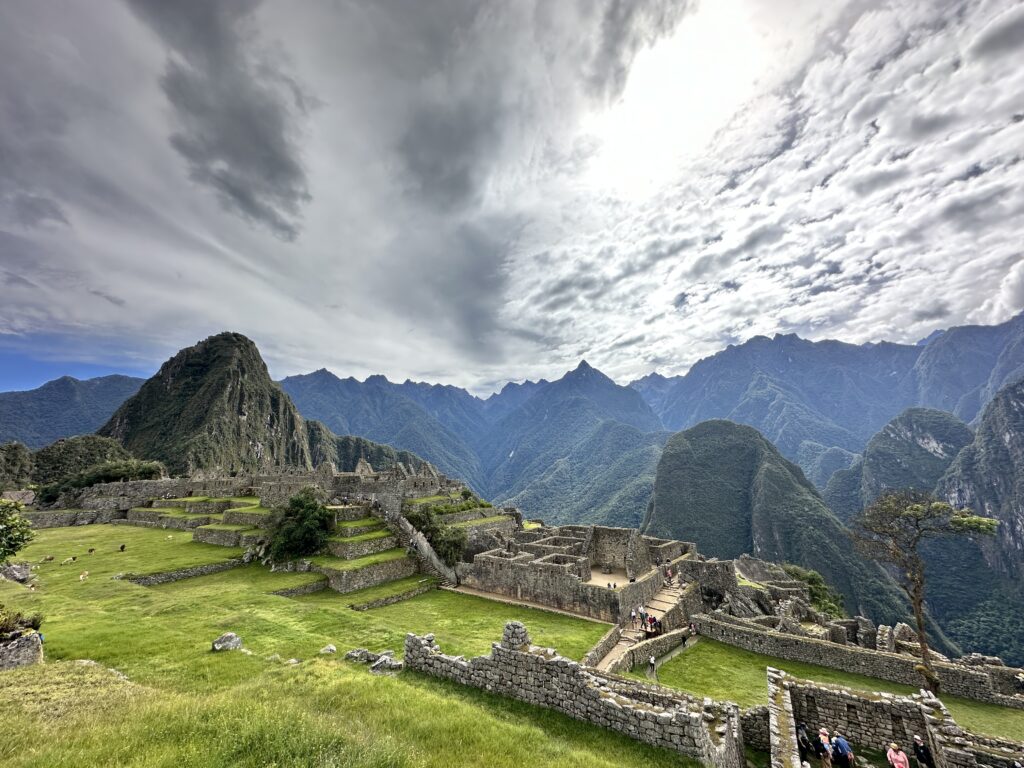
“Is this some mystical game of peek-a-boo?” I wonder as I gaze down on the sacred, cloud-shrouded site of Machu Picchu. The ancient settlement straddles a narrow mountain ridge nearly 9,000 feet high in the Peruvian Andes. The ancient city seems to hover between earth and sky. Its terraces drift in and out of view as the morning mist weaves through stone walls built for gods and kings. In this suspended moment, I begin to sense the spiritual meaning of Machu Picchu—a place where the veil between the visible and the divine feels astonishingly thin.
I watch in awe from an Inca terrace carved into the mountainside. From here, the view feels otherworldly—like peering through a veil into another time. Behind the ruins, a jungle-cloaked peak called Huayna Picchu rises like a verdant god. On either side of the citadel, terraces cascade down steep slopes in perfect rhythm, giant green steps tumbling toward the river far below.
Machu Picchu seems caught in a delicate balance, poised between earth and sky, the material and the divine. All around me, the Andes reach even higher—some summits more than ten thousand feet above—stretching into clouds that brush the blazing sun, the Incas’ beloved deity.
A City Wrapped in Mystery
An air of mystery clings to this place, much like at Stonehenge or among the Mayan temples hidden in the jungle. This 500- to 600-year-old stone city is among the most visited archaeological sites in the Western Hemisphere. More than a million people visit each year, yet its purpose remains elusive. Why did the Incas build it? And why, only 70 or 80 years later, did they abandon it unfinished?
Humbled, I descend the stone steps toward the ruins and pass through a doorway that once served as the modest city gate. When Yale historian Hiram Bingham first documented the site in 1911, the ancient city had long been reclaimed by the rainforest. Orchids—more than 300 species in pinks, yellows, and whites—twined through crumbling walls. Exotic birds darted overhead. Even now, a century later, the jungle still breathes around the stones, reclaiming what was once its own.
Seeking the Inca Story

Since Bingham’s discovery, archaeologists have wrestled with Machu Picchu’s secrets. He believed it to be a military fortress. Later, others speculated it was a sanctuary for priestesses, an agricultural testing ground, or an astronomical observatory. Most now believe it served as a royal estate for the great emperor Pachacuti.
What captivates me more, though, is not why it was built—but why it was abandoned. How did this sprawling complex remain hidden from the Spanish conquistadors, and from the rest of the world, for nearly 500 years? Some suggest the Incas simply left after Pachacuti’s death. Others point to epidemics or attacks from jungle tribes. My favorite story, and the one repeated by most guides, tells of a lightning strike that shattered a lintel in the Temple of the Sun. The Incas, interpreting it as a divine warning, fled in fear.
A Window Aligned with the Heavens
Imagining that moment, I pause at the base of the Temple of the Sun. The building itself is modest, barely larger than a single home, yet it feels charged with reverence.
A single second-story window draws my attention. At first glance it seems ordinary, yet it is aligned perfectly with the sunrise on the June solstice, heralding the start of winter in the Southern Hemisphere. At dawn, sunlight first pierces a distant portal high on the mountain. Moments later, the rays stream through this window like an arrow striking its mark.
The precision is breathtaking—proof that the Incas were as advanced in their understanding of the heavens as the ancient Europeans and Egyptians who designed their temples to track the sun. Standing before this observatory, I sense that shared devotion to light that connects sacred sites across continents—from the Andes to the Nile. Each civilization, in its own way, sought to anchor the cosmos to the earth and to mirror divine order in stone.
Want more stories like these? Subscribe to our newsletter, Journeys of the Soul, for bimonthly reflections, spiritual travel insights, and first look at new tours.
The Temple of the Condor
Descending through narrow streets, I reach a large triangular rock carved into the likeness of a condor’s head, its ruff shaped by a curved collar of stone. Behind it, a jagged cliff face forms the bird’s outstretched wings. This is the Temple of the Condor, honoring the great bird of the Andes, a messenger between heaven and earth. Beneath it lies a narrow passage leading to a tiny underground cell—its purpose long forgotten.
I stand quietly, imagining priests and pilgrims who once offered prayers here. Despite centuries of study, this site still guards its secrets. Even now, mystery holds sway—a humbling thought in our Information Age, when answers are only a voice command or a keystroke away.
Unveiling the Spiritual Meaning of Machu Picchu
Crossing a grassy plaza, I climb toward the city’s highest point and pause before a sacred stone called the Intihuatana, or “hitching post of the sun.” Roughly the size of a small car, it has sharply angled sides and a squat pillar rising from its top. The Incas used its shadows to mark equinoxes and solstices. Each pattern charted the dance between heaven and earth.
They understood that knowledge is power—a truth that still resonates today. Knowledge allows us to heal, to fly, to connect across oceans. It brings order and control. Yet as I wander these terraces, I sense another kind of power—one that reveals the spiritual meaning of Machu Picchu not through facts, but through feeling. The unknown nourishes imagination and humility, reminding us that mystery itself is sacred.
Mystery feeds imagination and humility. It stirs the poet, the dreamer, and the seeker within—calling us to explore, to hope, and to believe that what lies beyond our understanding might be more beautiful than anything we can explain. This quiet wonder keeps us reaching for what is sacred, even when we cannot name it.
A Door to Nowhere
Seeking solitude away from the chorus of voices and camera shutters, I wander down a terrace at the site’s edge. There, tucked into the rock, I find a finely carved doorway and a window leading into a small cave-like space, just large enough to stand in. The air inside smells of wet stone and earth. No carvings, no stairs—only silence and shadow. It feels like a threshold to another world.
Later, I learn that this hidden chamber is called Intimachay. Its window aligns with the sunrise on the summer solstice in December, the moment the Inca creation story begins. Legend tells that the first Incas emerged from a cave at that very time of year. I am grateful that I discovered this sacred space before learning its meaning—grateful to have met the mystery first, before reason arrived to define it.
The Gift of Wonder
As closing time nears, I make my way toward the exit. A pair of lizards rest on a stone doorway, still as sentinels. When startled, they dart into the cracks, like the mysteries of this place—alive, yet always just out of reach.
We may never know every answer about Machu Picchu, yet perhaps that is its truest lesson. Its enduring mystery invites us to experience the spiritual meaning of Machu Picchu—to surrender our need to explain and instead marvel at what is.
Albert Einstein called the mysterious “the source of all true art and science.” Machu Picchu embodies that truth. Here, wonder itself becomes sacred. It connects us to the Divine, the Great Mystery that threads through all creation. What greater blessing could there be?
About the Author

Katy Koontz is a longtime freelance writer, author, and editor whose work centers on spirituality, travel, and mind-body health. She is editor-in-chief of Spirituality & Health: A Unity Publication and formerly held the same role at Unity Magazine. Katy was named to the 2019 Folio: 100 list for editorial excellence, and her writing has earned honors from the Folio Eddie Awards and the Lowell Thomas Travel Journalism Awards of the Society of American Travel Writers. Learn more at katykoontz.com.

We Love Meeting New People
Kindred spirits find each other through sharing. When you invite friends to explore our Journeys of the Soul newsletter, we’ll thank you with meaningful rewards for growing the circle.
